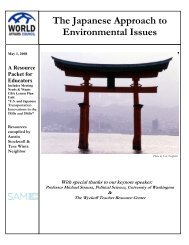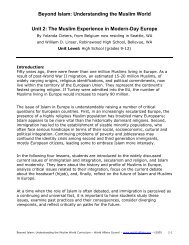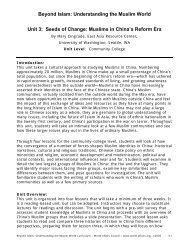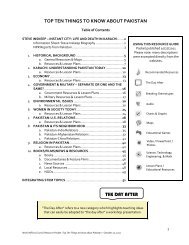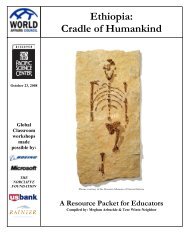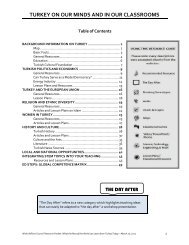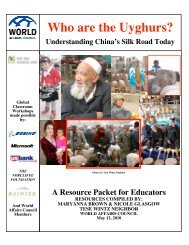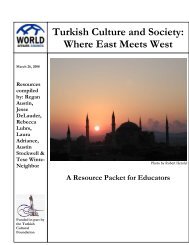The Question(s) of Tibet - World Affairs Council
The Question(s) of Tibet - World Affairs Council
The Question(s) of Tibet - World Affairs Council
You also want an ePaper? Increase the reach of your titles
YUMPU automatically turns print PDFs into web optimized ePapers that Google loves.
ENVIRONMENTAL ISSUES<br />
WORLD GLACIER MONITORING SERVICE<br />
http://www.geo.uzh.ch/microsite/wgms/index.html<br />
Today, the <strong>World</strong> Glacier Monitoring Service (WGMS) collects standardised observations on<br />
changes in mass, volume, area and length <strong>of</strong> glaciers with time (glacier fluctuations), as well as<br />
statistical information on the distribution <strong>of</strong> perennial surface ice in space (glacier inventories).<br />
Such glacier fluctuation and inventory data are high priority key variables in climate system<br />
monitoring; they form a basis for hydrological modelling with respect to possible effects <strong>of</strong><br />
atmospheric warming, and provide fundamental information in glaciology, glacial<br />
geomorphology and quaternary geology. <strong>The</strong> highest information density is found for the Alps<br />
and Scandinavia, where long and uninterrupted records are available.<br />
GLOBAL WARMING BENEFITS TO TIBET: CHINESE OFFICIAL (8/17/09)<br />
http://www.google.com/hostednews/afp/article/ALeqM5g1eE4Xw3njaW1MKpJRYOch4hOdLQ<br />
Global warming could prove devastating for the <strong>Tibet</strong>an plateau, the world's third‐largest store<br />
<strong>of</strong> ice, but it helps farming and tourism, Chinese state media said Tuesday, citing a leading<br />
expert. Qin Dahe, the former head <strong>of</strong> the China Meteorological Administration, made the<br />
comment in an otherwise gloomy assessment <strong>of</strong> the impact that rising temperatures will have<br />
on <strong>Tibet</strong>, according to the China Daily newspaper. "Warming is good for agriculture and<br />
tourism. It has increased the growing season <strong>of</strong> crops," said Qin, now a researcher with the<br />
Chinese Academy <strong>of</strong> Sciences. China is banking on tourism to help fund development in <strong>Tibet</strong>,<br />
one <strong>of</strong> its poorest regions, hoping that a railway to the region's capital Lhasa will boost visitor<br />
numbers. From January to July this year, more than 2.7 million tourists visited <strong>Tibet</strong>, nearly<br />
triple the number in the same period <strong>of</strong> 2008, the <strong>Tibet</strong> Daily said recently.<br />
While agriculture and tourism stand to benefit, Qin underlined a series <strong>of</strong> negative<br />
consequences that global warming will have in <strong>Tibet</strong> and surrounding areas.<br />
Deforestation, Desertification, Erosion, and other Environmental Issues<br />
SOUTHWEST TIBET MOUNTAINS (NASA)<br />
http://visibleearth.nasa.gov/view_rec.php?id=1422<br />
This spaceborne radar image covers a rugged mountainous area <strong>of</strong> southeast <strong>Tibet</strong>, about 90<br />
kilometers (56 miles) east <strong>of</strong> the city <strong>of</strong> Lhasa. In the lower right corner is a wide valley <strong>of</strong> the<br />
Lhasa River, which is populated with <strong>Tibet</strong>an farmers and yak herders, and includes the village<br />
<strong>of</strong> Menba. Mountains in this area reach about 5800 meters (19,000) feet above sea level, while<br />
the valley floors lie about 4300 meters (14,000 feet) above sea level. <strong>The</strong> Lhasa River is part <strong>of</strong><br />
the Brahmaputra River system, one <strong>of</strong> the larger rivers in southeast Asia eroding the <strong>Tibet</strong>an<br />
Plateau. <strong>The</strong> rugged relief in this area reflects the recent erosion <strong>of</strong> this part <strong>of</strong> the Plateau.<br />
Most <strong>of</strong> the rocks exposed outside <strong>of</strong> the river valleys are granites, which have a brown‐orange<br />
color on the image. In the upper left center <strong>of</strong> the image and in a few other patches, there are<br />
some older sedimentary and volcanic rocks that appear more bluish in the radar image.<br />
Geologists are using radar images like this one to map the distribution <strong>of</strong> different rock types<br />
and try to understand the history <strong>of</strong> the formation and erosion <strong>of</strong> the <strong>Tibet</strong>an Plateau.<br />
ruggedness <strong>of</strong> the terrain have precluded preventative measures that the Chinese government<br />
might otherwise undertake to control the release <strong>of</strong> the water. <strong>The</strong> top image shows the<br />
<strong>World</strong> <strong>Affairs</strong> <strong>Council</strong> Teacher Resource Packet – <strong>The</strong> <strong>Question</strong>(s) <strong>of</strong> <strong>Tibet</strong> February 28, 2011<br />
24



